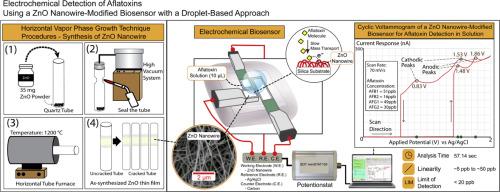Electrochemical detection of aflatoxins using a ZnO nanowire-modified biosensor with a droplet-based approach
IF 3.7
Q1 CHEMISTRY, ANALYTICAL
引用次数: 0
Abstract
Aflatoxin contamination poses significant health risks and food safety concerns, and necessitates the development of rapid, sensitive, and cost-effective detection methods. This study reports the development of a portable, cost-effective electrochemical biosensor using zinc oxide (ZnO) nanowires synthesized via the Horizontal Vapor Phase Crystal (HVPC) growth technique for the detection of multiple aflatoxin types. The sensor integrates a droplet-based cyclic voltammetry (CV) system with a ZnO-modified working electrode on a disposable printed chip. Morphological and elemental characterization confirmed the formation of high-purity ZnO nanowires with diameters predominantly below 100 nm. The sensor exhibited a wide and stable potential window (–0.48 V to +2.00 V), hydrophobic surface properties, and Ohmic electrical behavior. Electrochemical measurements revealed four distinct redox peaks, corresponding likely to the mixed standard of AFB1, AFB2, AFG1, and AFG2, with anodic and cathodic responses increasing linearly across the 5 % to 50 % aflatoxin dilution range, which is approximately from 5ppb to 50ppb. The calibration curves yielded high linearity (R² > 0.97), and the calculated limits of detection ranged from 4.35 to 15 ppb—below the FDA’s 20 ppb regulatory threshold. With a rapid response time (∼57 s) and minimal sample volume (10 μL), this sensor offers a practical alternative to traditional chromatographic or spectroscopic methods. Although this study was limited to standard solutions, the findings demonstrate strong potential for real-time aflatoxin monitoring in food and agricultural settings, particularly in resource-limited environments.

ZnO纳米线修饰生物传感器微滴法检测黄曲霉毒素
黄曲霉毒素污染构成重大的健康风险和食品安全问题,需要开发快速、敏感和具有成本效益的检测方法。本研究利用水平气相晶体(HVPC)生长技术合成氧化锌(ZnO)纳米线,开发了一种便携式、高性价比的电化学生物传感器,用于检测多种黄曲霉毒素类型。该传感器将基于液滴的循环伏安法(CV)系统与zno修饰的工作电极集成在一次性印刷芯片上。形貌和元素表征证实形成了直径主要小于100 nm的高纯度ZnO纳米线。该传感器具有宽而稳定的电位窗口(-0.48 V至+2.00 V),疏水表面性能和欧姆电行为。电化学测量显示了四个不同的氧化还原峰,可能对应于AFB1, AFB2, AFG1和AFG2的混合标准,阳极和阴极响应在5%至50%黄曲霉毒素稀释范围内线性增加,大约从5ppb到50ppb。校准曲线线性度高(R²>;0.97),计算的检测限范围为4.35至15 ppb -低于FDA的20 ppb监管阈值。该传感器具有快速响应时间(~ 57 s)和最小样品量(10 μL),是传统色谱或光谱方法的实用替代方案。虽然这项研究仅限于标准解决方案,但研究结果表明,在食品和农业环境中,特别是在资源有限的环境中,黄曲霉毒素实时监测具有很大的潜力。
本文章由计算机程序翻译,如有差异,请以英文原文为准。
求助全文
约1分钟内获得全文
求助全文

 求助内容:
求助内容: 应助结果提醒方式:
应助结果提醒方式:


